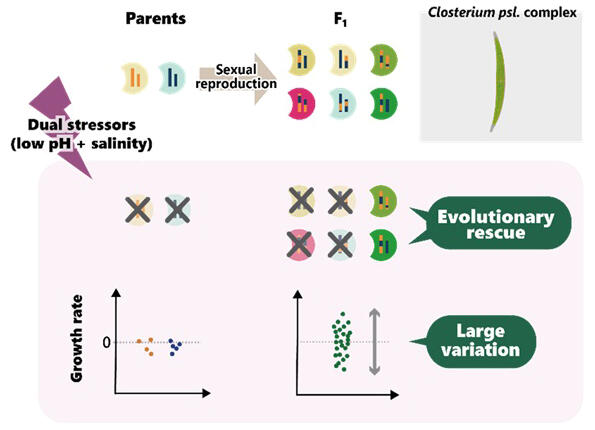Project Researcher Yawako W. Kawaguchi and Associate Professor Masato Yamamichi from the National Institute of Genetics announced that they measured the growth rates of the freshwater unicellular green alga Closterium peracerosum-strigosum-littorale complex in a culture environment subjected to two types of stress—salinity and acidity—and discovered that a single episode of sexual reproduction can produce large variation in population growth rates. This finding is expected to contribute to understanding mechanisms by which organisms adapt to rapid environmental changes, including conservation of rare species, wildlife management, and evolution of antibiotic and pesticide resistance, and avoid extinction. The researchers' results were published in the Journal of Evolutionary Biology, an international academic journal, on April 17.

Provided by the National Institute of Genetics
Organisms that reproduce sexually have slower reproduction rates and bear many costs compared with asexually reproducing organisms that can proliferate indefinitely. Why sexual reproduction has evolved and been maintained regardless of this remains a long-standing topic of debate in evolutionary biology without a clear conclusion.
In actual ecosystems, multiple stress factors often act simultaneously, and it is thought that this is likely to increase the number of genes involved in adaptation.
From this background, the research group cultured the parental population of Closterium peracerosum-strigosum-littorale complex and the F1 population, obtained through a single episode of sexual reproduction by the parental population—in an environment subjected to two stresses, salinity and acidity (low pH), and measured their growth rates.
As a result, growth of some F1 populations was observed even under severe environmental conditions of low pH and high salinity where the parental strains could not proliferate. Kawaguchi had previously revealed that pairs of parental strains performing sexual reproduction possess many genes with different copy numbers.
When examining copy numbers focusing on stress-related genes, many pH stress-related genes showed differences in copy numbers between parental strains, unlike salt stress-related genes.
The study demonstrated that recombination and copy number variation occurring within a single episode of sexual reproduction can cause variation in growth rates of offspring and potentially trigger evolutionary rescue.
Yamamichi commented: "Phytoplankton have the potential to become important model organisms in ecology and evolutionary biology. Our laboratory particularly focuses on 'evolutionary rescue,' where organisms avoid extinction through rapid adaptive evolution in response to environmental fluctuations. In the future, we would like to advance research combining culture experiments, genome analysis, and mathematical model analysis, focusing on environmental stress, interspecies competition, and predator-prey relationships with zooplankton."
Journal Information
Publication: Journal of Evolutionary Biology
Title: A single episode of sexual reproduction can produce large variation in population growth rates under dual stressors
DOI: 10.1093/jeb/voaf041
This article has been translated by JST with permission from The Science News Ltd. (https://sci-news.co.jp/). Unauthorized reproduction of the article and photographs is prohibited.




